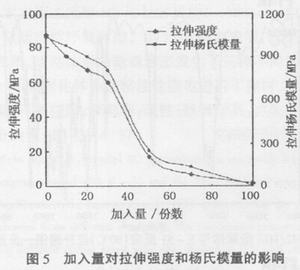After the modified epoxy resin was cured at 100°C for 3 h with MDA as a curing agent, the mechanical properties were tested. The results are as follows:

From Fig. 5, it can be seen that the tensile strength and Young's modulus have been decreasing with the increase of the amount of polyurethane prepolymer added; the tensile strength and Young's modulus are sharpened after the addition amount reaches a certain level (30 parts). Decline; With the increase in the amount of addition (50 copies later), although the tensile strength and Young's modulus still gradually decreased, but the decline was significantly slower compared with the previous stage.
With the increase of the soft segment in the polymer, the flexibility of the polymer increases and the rigidity decreases, so the tensile strength and the Young's modulus always decrease. At the same time, the system produced a microscopic phase separation after curing, and the polyurethane rubber particles were dispersed in the continuous phase of the epoxy resin as a dispersed phase. The role of the rubber phase in the different stages is also different. When the amount is small, the rubber phase will act as a stress concentration agent that will trigger the silver lines and prevent the silver lines from further development and absorb energy. The nature of the continuous phase of the resin, and thus the tensile strength and Young's modulus, are reduced by the introduction of flexible segments, but the decrease is relatively small; after the addition amount reaches a certain level (30 parts), due to the aggregation of the polyurethane rubber particles, The particle size gradually increases, the phase separation degree deepens, and the rubber phase is similar to the defect of the system. The dominant role of the system is that the continuous phase of the epoxy resin is destroyed, so the tensile strength and the Young's modulus are greatly reduced; as the added amount continues to increase Polyurethane gradually aggregated to form a continuous phase, and the system gradually exhibited the properties of polyurethanes. Although the tensile strength and Young's modulus were decreased, the decrease rate was somewhat lower than that in the previous stage.

As can be seen from Figure 6, the elongation at break increases as the amount of polyurethane prepolymer added increases. After the addition amount reaches a certain level (70 parts), the elongation at break increases rapidly. With the increase of the amount of prepolymer added, the impact strength increased continuously, the first peak appeared when 10 people were added, and then the impact strength began to decrease with the increase of the amount of prepolymer added; the amount reached 50 After the serving, the impact strength began to increase again, and the second peak appeared when the amount was 70 parts, and then the impact strength began to fall again.
With the increase of the soft segment in the polymer, the flexibility of the polymer increases and the rigidity decreases, so the elongation at break always increases; after the performance of the system changes to the properties of the polyurethane, the elongation at break increases rapidly.
Also due to the increased flexibility of the system and the different roles of the rubber phase at different stages, there are two peaks in the change in impact strength. When the rubber phase is mainly based on toughening, the impact strength is increased; when the rubber phase is mainly used to destroy the main curing system, the impact strength is decreased; after the polyurethane forms a continuous phase, the impact strength is increased; when the added amount is too high, due to The system became softer and the impact strength decreased again. At 100 parts, the strength was lower than that of pure epoxy resin. In addition, when 70 and 100 parts were applied, the impact test piece was tough rubber and was bent and hit continuously.

It can be seen from Figure 7 that when the content of polyurethane rubber phase is small (20 parts), the failure form shows brittle fracture; when the content of polyurethane rubber phase reaches a certain degree (50 parts), the yield point appears on the stress-strain curve, and the failure form shows It is a ductile fracture; in the case of a high content of polyurethane rubber (100 parts), the failure form appears as a ductile fracture. In fact, although the amount of rubber added is 50 parts, the failure mode is ductile fracture, but the tensile strength is already very low at this time.

From Fig. 8, it can be seen that as the addition amount of the polyurethane prepolymer increases, the flexural strength and the flexural modulus always decrease, which is also a result of the decrease in the rigidity of the system. In addition, after the polyurethane prepolymer was added to 50 parts, the cured resin was too soft, and the bending strength and Young's modulus of bending could not be measured.
(to be continued)